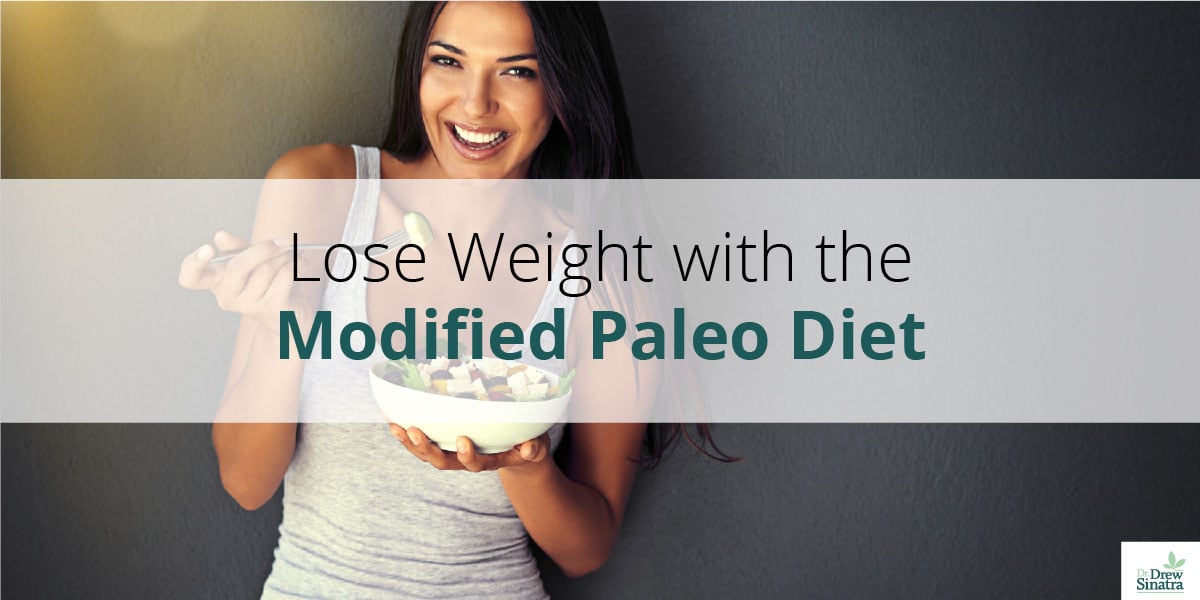
Patients often ask me for the best diet to follow to regain their health, feel more vital, or to lose weight. Over the years I’ve tried many diets with my patients, and the one that seems to foster the greatest positive change is what I call the “Modified Paleo Diet.”
This style of eating is based on the Paleolithic (Paleo) diet—but it’s less restrictive, so it’s easier to stick with over the long haul. In my practice this diet has proven over and over again to be the best way to lose weight, and more importantly to help restore healthy eating habits.
What Is a “Modified Paleo Diet?”
The Paleo diet is based on what our ancestors ate before the agricultural revolution 10,000 years ago. Genetically we’re practically identical to our Paleolithic ancestors. Yet, our modern day Western diet is drastically different in macro- and micronutrients, phytonutrients, fiber content, and electrolytes compared to what our ancestors ate. Plus, we’re eating a very different composition of fats, proteins, and particularly carbohydrates.
Our ancestors were hunters and gatherers who consumed foods like berries, shoots, flowers, bone marrow, fish, roots, bulbs, and nuts. Because our ancestors relied on finding food rather than cultivating it, grains and dairy were not available, and thus were not consumed.
The modern day version of the Paleo diet emphasizes eating whole foods, including vegetables, pasture raised and grass fed meats, fish, eggs, fruits, and nuts.
Some people say the Paleo diet should be the standard for contemporary human nutrition, considering our genetic similarities to our Paleolithic ancestors. I wholeheartedly agree. In my medical practice, I’ve seen the Paleo diet reverse many health concerns, beginning with weight management.
The Paleo Diet Reverses Many Eating Habits that Have Led to Obesity
As our diets have evolved over the years, obesity has reached epidemic proportions in the United States. Alarmingly, over one-third of Americans are obese—and our high-sugar, high-carbohydrate, low-fat diets are a huge part of the problem.
Luckily, I didn’t subscribe to the low-fat diet craze that was founded on faulty and misunderstood science. In medical school, I was taught that certain fats are healthy including coconut oil, omega 3 fatty acids, and eggs, and that unhealthy fats like trans fats are the ones responsible for causing free radical damage (stress) in the body.
The food industry and medical establishment not only demonized the good fats, but recommended fat-free, higher-carbohydrate diets as a solution. As a result, diabetes and obesity began to steadily increase. Luckily, now the research and science on fats is irrefutable, the low-fat diet craze is slowly coming to an end.
Unlike the typical American diet, the Paleo diet is filled with low-glycemic carbohydrates and high-quality fats and proteins. This is a powerful combination for highly effective and reliable weight loss.
In fact, one of the most shocking differences between the Paleo and Western diets is the consumption of refined sugar. Because refined sugar did not exist in hunter-gatherer societies, literally no sugar was consumed per year. By comparison, in 2000 the average yearly consumption of sugar in the United States was a whopping 152 lbs. per person!
When patients embark on a Paleo type diet, a decrease in weight is often the first change they observe. While individual results vary based on factors such as gender, age, and weight—most of my patients who have followed a Modified Paleo Diet lose from five to 25 pounds. In fact, I’ve seen patients lose 25 pounds in as little as two months! This clearly makes it the best way to lose weight in my book.
In fact, recently while visiting family in Vancouver where I used to practice medicine, I bumped into an old patient of mine, Jennifer, at the gym—and I didn’t recognize her at first. After two years of eating a Paleo diet, she had lost 78 pounds and is continuing to lose weight. Her exercise program has stayed consistent—but by giving up grains, legumes, and dairy, she slimmed down dramatically.
What Can You Eat on a Modified Paleo Diet?
As I mentioned earlier, a traditional Paleo diet is void of all grains, dairy products, and legumes (i.e., beans, peanuts, soy). But completely eliminating these foods can be overwhelming for most people. So, I have added in some of these foods to help make the Paleo diet easier to follow and one of the best ways obtain a healthy weight. So, what can you eat?
- Gluten-free grains and legumes—if properly prepared. While I don’t recommend eating foods with gluten, I do allow for the consumption of some gluten-free grains and legumes—if prepared properly. For example, if legumes are soaked then cooked, these foods will contain fewer “anti-nutrients” like phytic acid and lectins and will be much easier to digest. With gluten-free grains, I allow rice, millet, quinoa, and buckwheat. As for legumes, I allow lentils, beans, and fermented soy products like miso, tempeh, and natto. Grains and legumes should be consumed in moderation, however, as they can raise blood sugar and subsequently insulin levels. For example, it’s okay to eat a half cup of rice as long as you eat it with enough protein and fats to blunt the impending insulin response.
- Organic grass-fed butter and ghee. With a Modified Paleo Diet, I recommend staying away from most dairy products since many people unknowingly react to milk products. But for those who are able to digest grass-fed butter and/or ghee I allow these oils because they are excellent sources of fats, as well as vitamins A and K2. Grass-fed butter and ghee also contain butyric acid, a short chain fatty acid that provides fuel for your intestinal cells and calms the immune system. Plus, it can increase insulin sensitivity.
- The right fats. Our bodies need healthy fats to function optimally. That’s because fats support the synthesis of sex hormones, help to absorb vitamins, convert into energy, and support brain function. There are fats you need to avoid—such as trans fats which can increase risk for heart disease—but good fats are important for optimal health. One of my favorite sources of fats is coconut oil. I use it for cooking, baking, as a spread—and even add it to my coffee. Coconut oil is a tremendously healthy saturated fat that contains medium chain triglycerides (MCTs) like caprylic and lauric acid. These MCTs have antibacterial, antifungal, and antioxidant properties.
- Fruits and vegetables. Vegetables are an excellent dietary staple, and most can be eaten in almost unlimited amounts. You do, however, want to limit starchy vegetables like potatoes, yams, sweet potatoes, and winter squash, which can spike your blood sugar. With fruit, it is okay to eat 2-3 servings of fruits in a day, but eating more than that may give you too much sugar for your body to handle.
- Protein. For protein sources I recommend grass-fed and/or pasture-raised beef, chicken, pork, lamb, turkey, bison, and cold water fish (especially Alaskan salmon and black cod). These foods can be found at farmers markets, online, or at markets that contain organic foods.
Modified Paleo diet recipes should be simple and balanced. For example, you could eat baked sweet potato fries with a 4–6 ounce grass-fed steak (baked or grilled), lightly steamed broccoli with grass-fed butter or olive oil drizzled on top, and a colorful salad with olive oil.
Ideally, you want to fill your plate with a rainbow-colored assortment of vegetables (raw and cooked), a small protein source (meat, seafood, tempeh, etc.), a small amount of carbohydrates (quinoa, short-grain rice, lentils, etc.), and some healthy fats (olive or coconut oil). Also, if you’re a coffee drinker, it’s okay to continue drinking it on the Modified Paleo Diet. But you want to ether drink it black since milk is not allowed, unless you choose coconut or almond milk as a substitute.
Be Patient, the First Few Days Are the Hardest
If you are radically changing your diet, the first few days will be the hardest as your body begins to detoxify. Many people, for example, go through sugar withdrawal—and withdrawal symptoms like headaches, fatigue, and irritability are not uncommon. But hang in there, because those unwanted symptoms will subside and you will start to reap the benefits.
Within a few weeks you should notice that you feel amazing. As you eat healthier and lose weight, you will find that you have more energy and that you even sleep more soundly. Plus, by getting off of the “sugar rollercoaster” you should find that your moods are more even. You may even notice that your clothing fits better—often in less time than you ever imagined.


